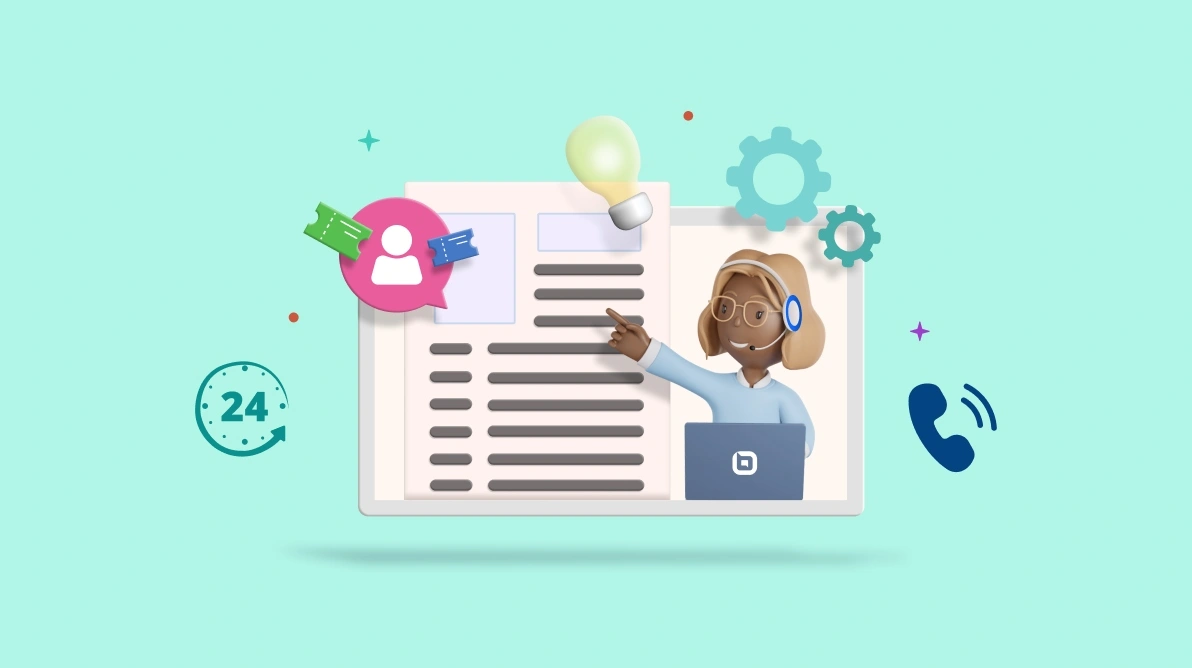Nothing drives profitability more effectively than delivering exceptional customer service.
This includes fast, accurate, and efficient responses and resolutions for client issues.
However, traditional manual customer service methods have proven to be slow, error-prone, and increasingly unproductive. To overcome these challenges, businesses are turning to modern IT help desks for streamlined customer service management.
So, what is it about cloud-based IT helpdesk support that makes it highly sought-after?
In this article, we’ll explore what an IT help desk is, how it works, and why it’s transforming customer service. You’ll discover its core features, the benefits it delivers, and best practices for maximizing its impact.
What is IT help desk?
An IT help desk is simply a customer service tool featuring an automated ticket system that helps streamline the management of technical support requests and issues more efficiently.
It converts support requests to tickets and routes them to the right support agent for a fast and accurate resolution or response.
This IT service desk enables customer service agents to perform their tasks efficiently and accurately.
Types of IT service desks
Ticketing software can operate in different ways. The following are the three common types of IT help desk ticketing systems:
- Cloud-based (SaaS): A type of ticketing software that strictly operates over the internet. It has an easy setup process with instant login. Additionally, it manages all the processes in a central repository and can integrate with other systems or apps.
- On-premises (self-hosted): This ticketing software includes secure data storage through a private web server within the company. The support ticket system is managed and maintained on site.
- Open source: In this type of help desk, the company can modify the source code of the software to suit their business needs.
How does an IT help desk actually work?
In any business, clients expect instant responses to their issues. This forces most businesses to adopt IT desk help systems to ensure seamless online customer service.
Here is a summary of the entire process:
- When a client encounters an issue or has an inquiry, they contact the customer support team via a communication channel, say email. The minute they send an email to support, the process begins. This email is automatically converted to a ticket in an IT help desk service.
- This triggers an automated notification that is sent to the support team about the new ticket. Clients also receive a notification to confirm that their email has been successfully created as a ticket and is being worked on.
- Immediately, the ticket is routed to the right support agent who specializes in the area of concern. The support agent will try to resolve the issue or respond to the inquiry of the client.
- Any progress made on the ticket will be updated in it and the client will receive notifications about it. Once the issue is fixed, the agent updates the status of the ticket as “Closed.”
Additional information
- If the issue is resolved but the agent fails to close the ticket, the IT service desk ticketing system will automatically close the ticket.
- When tickets concern the same issue from different customers, the solution is converted to a knowledge base article for future reference. This helps clients and other support agents easily resolve similar issues.
What is the difference between an IT help desk and IT service desk?
The terms “IT help desk” and “IT service desk” are often used interchangeably. However, they do have some differences in scope, focus, functionality, and communication parties.
| IT Help Desk | IT Service Desk |
| Involves providing reactive support to end-users. | Involves providing proactive support for businesses. |
| Focuses on immediate incident resolution of the end-users’ short-term issues. | Focuses on addressing the overall IT service management practices that require long-term solutions. |
| Consists of support tools that are designed to troubleshoot and provide solutions quickly. | Consists of comprehensive tools and processes that help manage the full lifecycle of IT services of a business. |
| Communication is one-on-one interaction between an end-user and a help desk support agent. | Communication involves many stakeholders such as end-users, the IT support team, and the IT service management team. |
In summary, both IT help desks and IT service desks can assist end-users with resolving technical problems.
What sets them apart is that service desks handle a wider range of tasks related to managing IT services, while a help desk mainly deals with resolving issues that require immediate attention.
Optimize your IT support with BoldDesk®
An IT help desk support tool performs various customer service functions aimed at the common goal of customer satisfaction.
For the software to serve its purpose fully, it needs to have the following features:
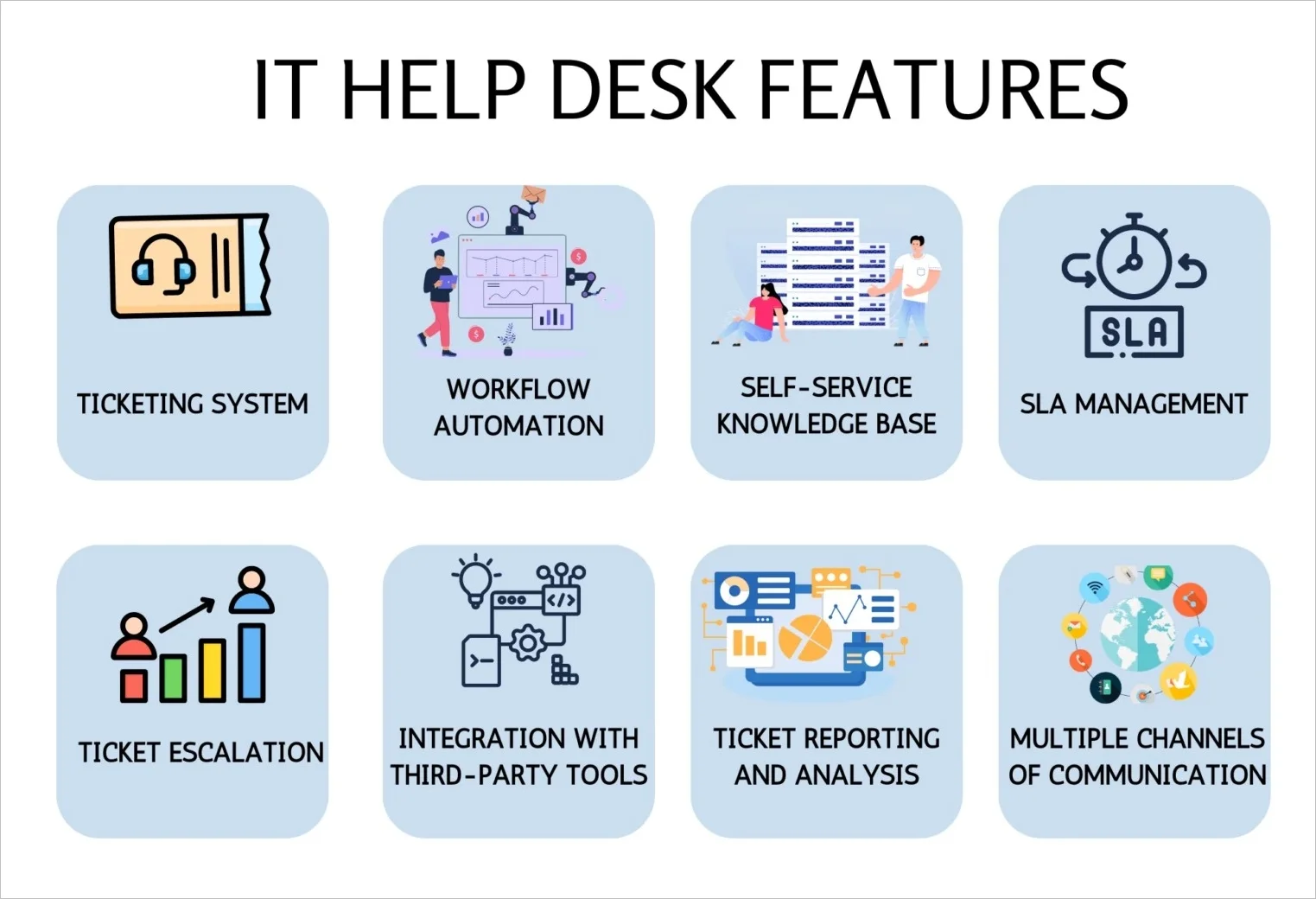
Ticketing system
Every help desk has a ticketing process feature. This involves operations such as ticket conversion, routing, assignment, escalation, tagging, and closure.
When clients have complaints or queries, they contact the support team for solutions. Their customer service requests auto-convert to support tickets and routed to the right agent for fast and efficient resolution.
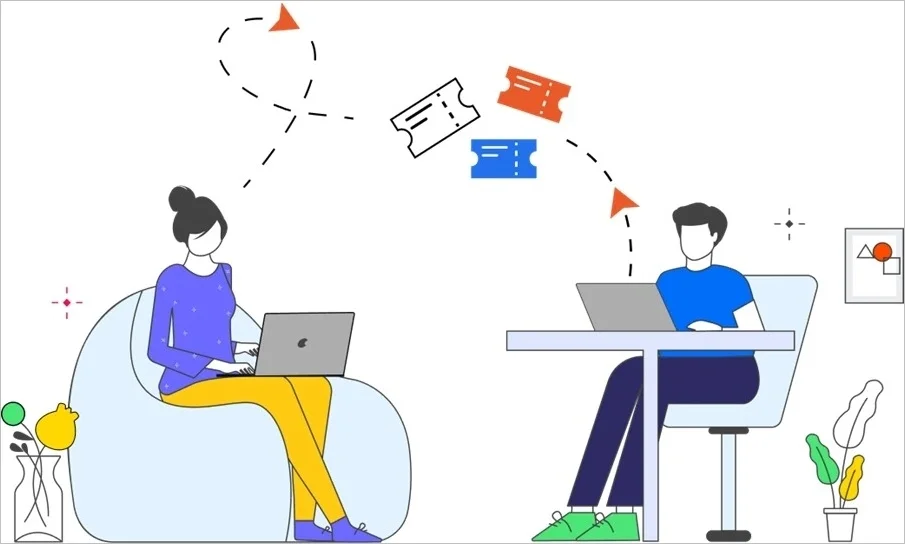
The IT helpdesk ticketing system stores conversations in tickets for support agents to reference in future issues so that clients don’t have to provide the same details every time.
This feature also allows agents to look back on similar issues to reach a resolution more quickly. Thus, the act of solving issues builds up a valuable resource for agents.
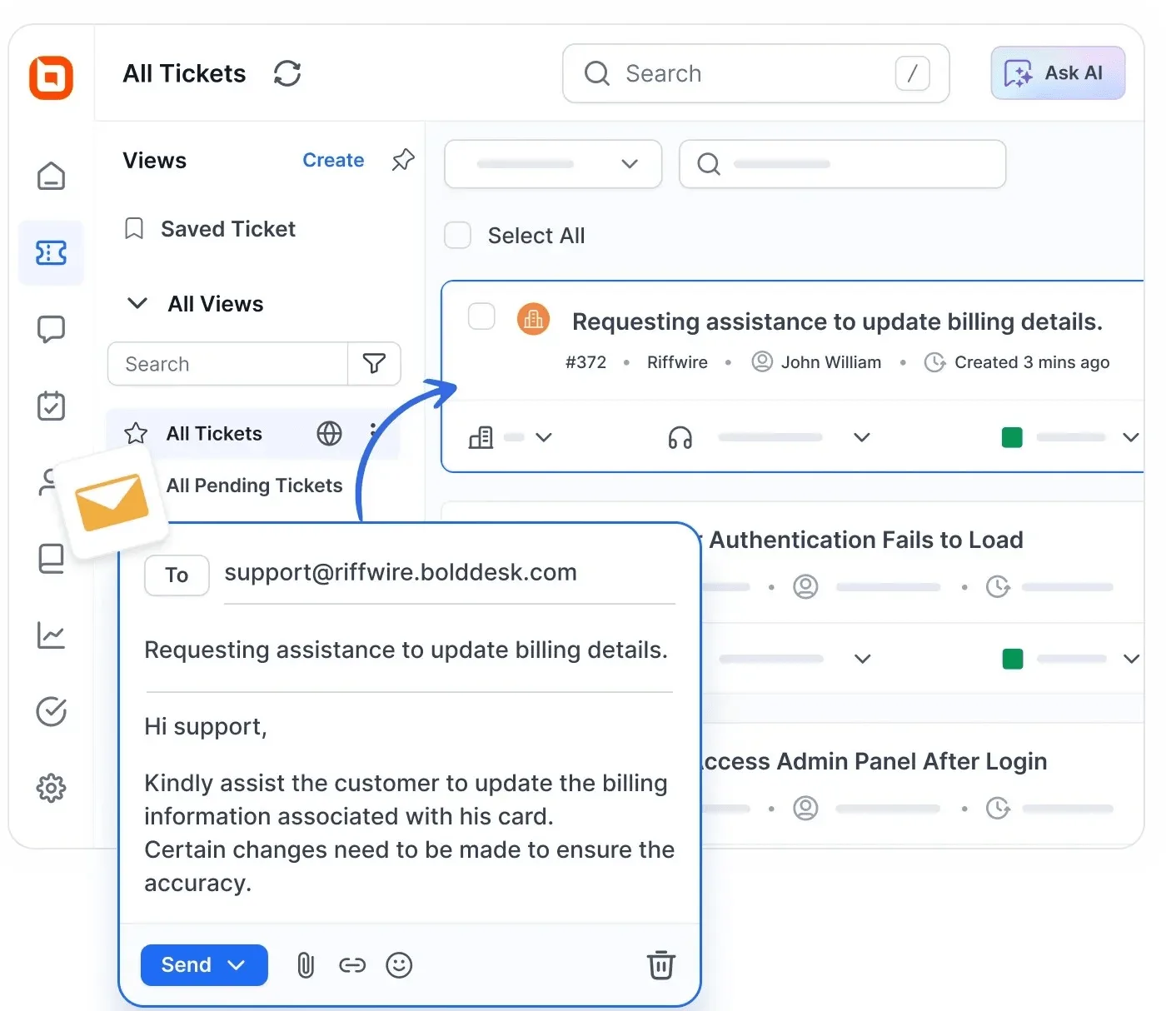
Clients enjoy quicker responses that satisfy their needs, and it encourages their loyalty and retention as a customer.
Workflow automation
Manual, repetitive customer support operations tend to be slow, prone to errors, and tiresome too. The solution to this problem is to leverage automation in your help desk.
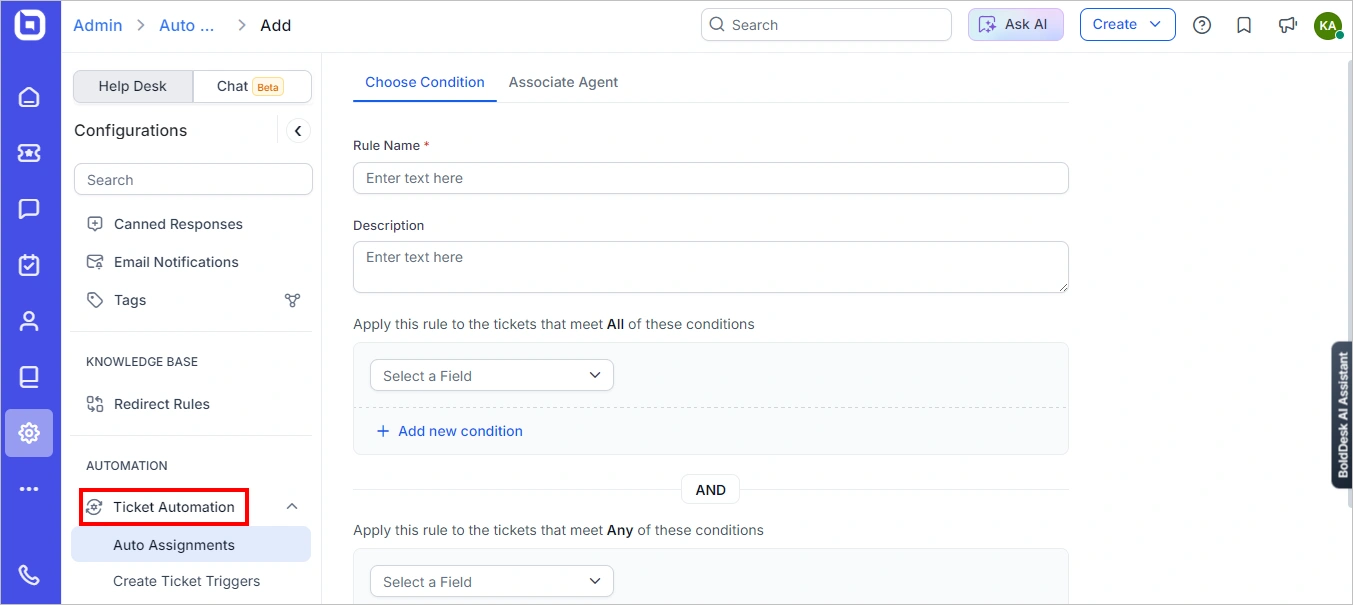
With help desk automation features, these manual and recurring processes get automatic resolutions.
Some popular automation that are vital to an IT help desk support software include:
- SLA alerts, reminders and notifications
- Email-to-ticket conversion
- Ticket routing and categorization
- Canned responses
These automations help agents be more productive. They help in reducing customer service response time by ensuring customer issues receive fast responses, while eliminating most, if not all, errors along the way.
Agents are able to focus on the problems that need urgent attention, free of overhead distractions.
AI-powered features
AI-powered support tools make life easier for your customer service team by streamlining everyday tasks.
With AI Copilot for instance, agents can instantly get suggestions for helpful knowledge base articles, quickly summarize long ticket threads, and generate response drafts tailored to each case.
Moreover, you can provide 24/7 virtual support with AI agents that can resolve queries, fetch order details through external APIs, cancel requests, and even adjust tone to match your brand’s voice.
From drafting replies and summarizing ticket history to automating refunds and CRM updates, AI actions help to handle the repetitive work so your team can focus on what matters most, helping customers.
Self-service knowledge base
A knowledge base is an essential feature of any IT help desk support solution, as it enables efficient self-service for users.
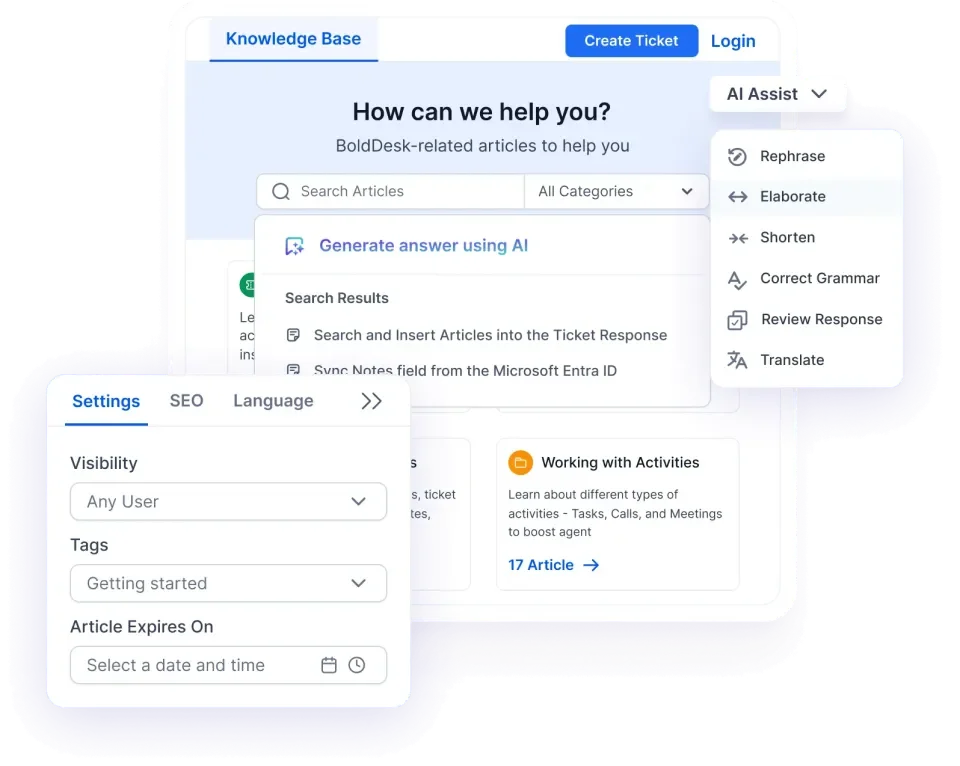
A knowledge base is a central repository of all the relevant information about the brand and the company in general, from the most basic to very complex details. Some of this information includes:
- Frequently asked question articles
- Manuals
- How-to videos and articles
With a self-service tool, clients can resolve issues freely on their own. As a result, their experience with the company or product is improved.
In addition, their satisfaction levels rise because they feel that the company values their time and intelligence, trusting them to figure out things on their own if they wish.
Answers aren’t kept locked away behind a support system. Customers can seek answers using the methods they prefer.
SLA management
The best IT service desk includes service-level agreement (SLA) management features that help support teams keep up with the SLA terms their clients expect.
These features apply automation rules to tickets, where certain conditions must be met in order for specific actions to execute.
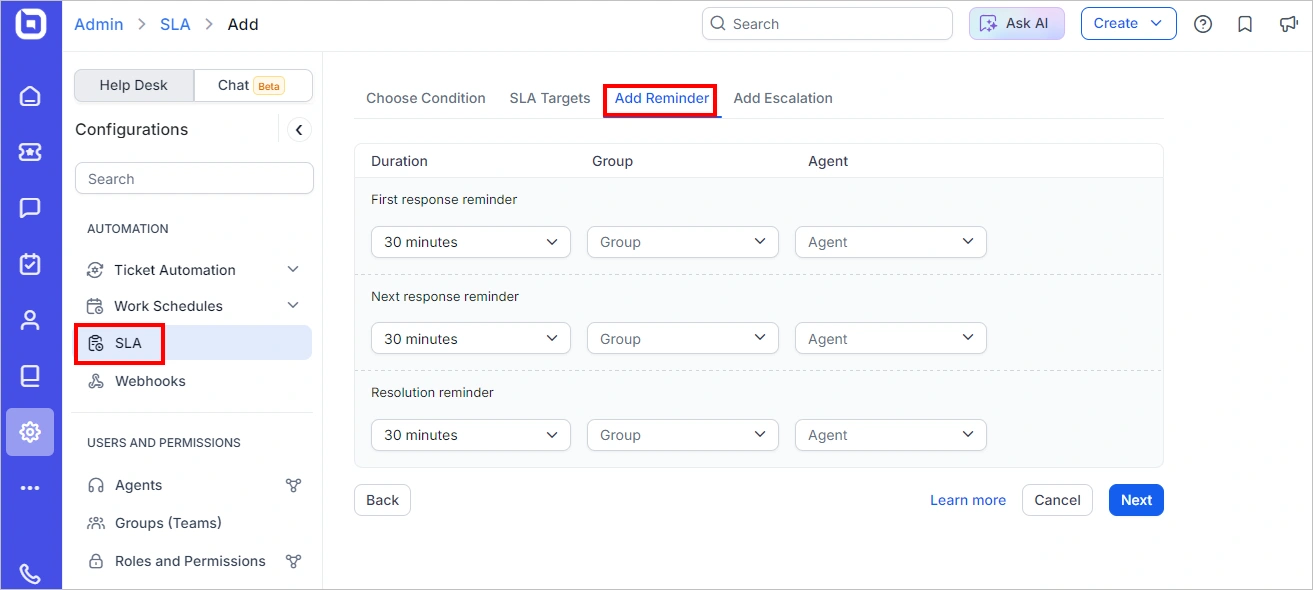
For instance, time and event triggers run after a set period of time or a certain event, respectively, which prompt SLA alerts, reminders, and notifications to be sent to clients, agents, or support leads.
These work together to ensure agents resolve all issues within the target time outlined in the SLA, based on their priority.
SLAs help agents maintain a high level of service. Agents perform tasks on time, within the stipulated conditions and set target times of the SLA. Delivering on the terms of the SLA boosts customer experience and customer satisfaction levels.
Additionally, complex issues may take longer to solve beyond the ticket resolution times specified in the SLA. In such scenarios, the support manager may need to intervene.
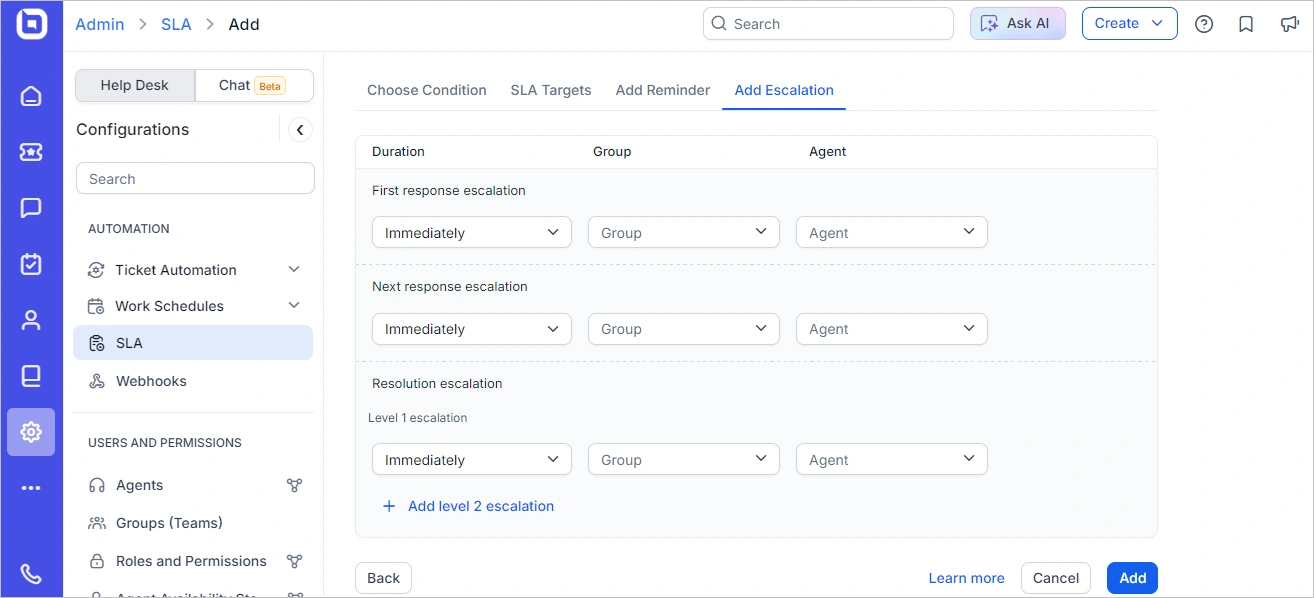
To ensure a time-consuming issue isn’t overlooked by the customer service management, an IT support desk can automatically send an alert to the team lead when a ticket is close to passing its due date.
The lead can then either ask the agent in charge of the issue to resolve it fast or route it to another support agent with more expertise to deal with the issue. This ensures issues are resolved on time and error-free, and clients are satisfied.
Integration with third-party tools
Most companies use multiple third-party apps and systems that help them in their daily operations in various sectors of the business.
A business can integrate their IT help desk with these third-party tools to ensure a seamless workflow and better management of their various systems.
Examples of such third-party tools include:
- Jira
- Microsoft Outlook
- Microsoft Teams
These tools largely help increase agent productivity but can become limiting if their data is restricted to the tools themselves.
Integrations with other software, including IT service desk, removes boundaries to getting things done.
Ticket reporting and analysis
An IT support desk commonly has built-in reports and analytics features in their customer service portal.
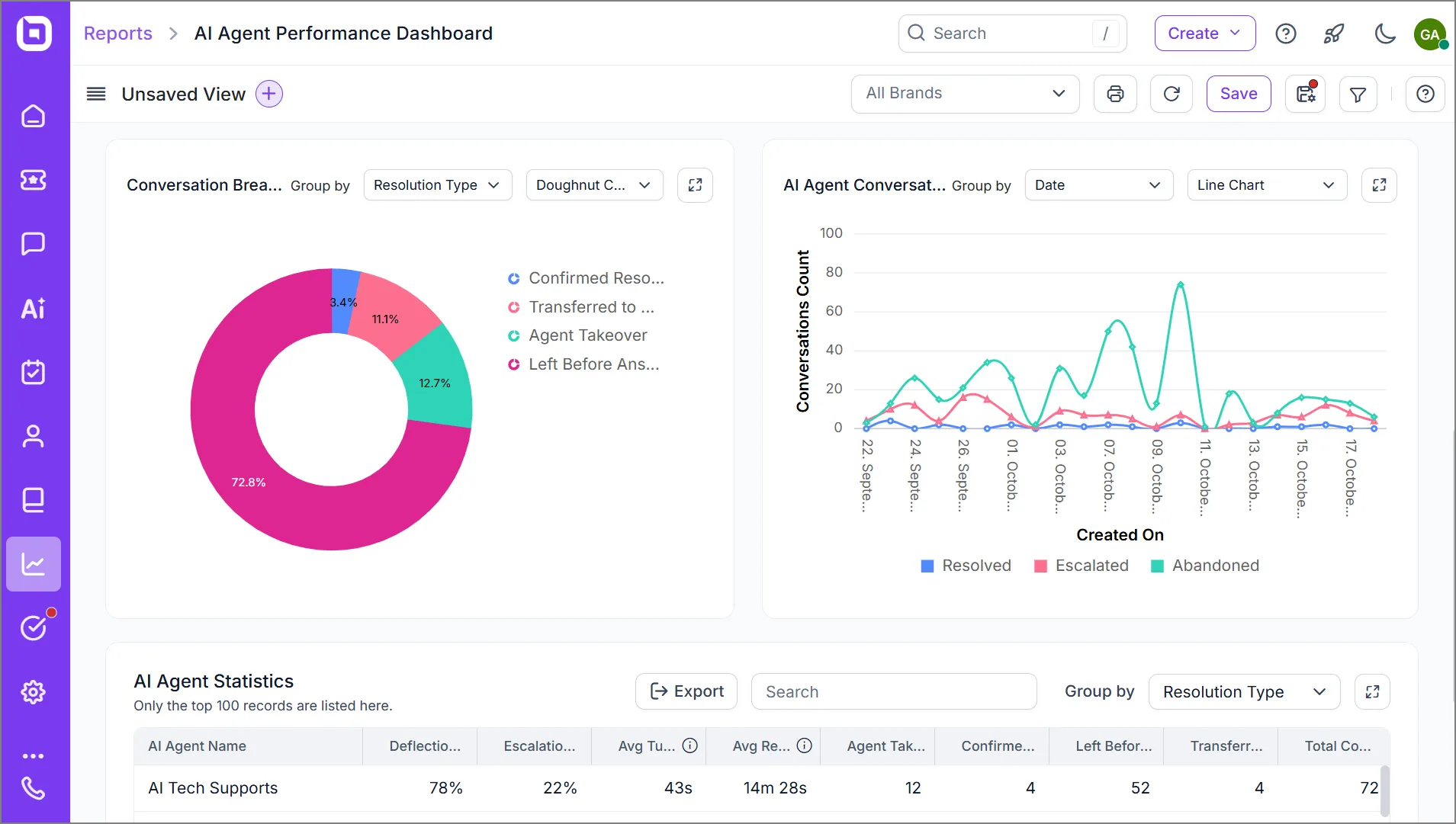
These provide statistical data on different support-related metrics to support leads, who can derive real-time insights on how the agents, the brands, or the company perform. Examples of reported metrics include:
- SLA breaches and achievements
- Response and resolution rates
- Ticket status, ticket inflow, tickets pending or overdue
- Agent performance
- Customer satisfaction rates
These data help the company identify what their customers prefer, areas to improve, and agents who need more training in order to improve customer service.
Omnichannel support
Integrating multiple touchpoints such as email, social media, and live chat into one platform, ensures seamless customer interactions across all channels.
This unified approach guarantees that every support query or ticket request reaches the customer service management team promptly and is addressed within the designated timeframe.
With omnichannel customer service, end users can effortlessly connect with agents via their preferred channels, while the help desk system automatically converts all incoming requests into manageable tickets, enabling agents to efficiently resolve issues regardless of the communication method used.
Different IT help desk support communication channels
Clients need to have fast, reliable ways to reach out to the customer service team of a company for help whenever any issues arise. It is vital for your ticketing software to support several channels.
These channels can include:
Live chat support
Live chat software is a highly effective tool for providing real-time customer assistance, allowing businesses to resolve issues quickly and improve customer satisfaction.
By embedding a live chat widget on websites or mobile apps, companies can offer instant help without the delays associated with email or phone support.
This immediate response capability enhances customer experiences, as clients can get quick answers to their questions or solutions to their problems.
For support agents, live chat support offers the advantage of handling issues that require customer input in one go, as they can immediately elicit more information from the customer, including visuals like screenshots, instead of waiting for email replies, increasing their efficiency.
Email-based support
Using email as a medium for clients and support agents to communicate is one of the best options. It is the most common channel since it is nearly universal. With emails, communication is asynchronous.
Clients don’t waste time in queues or on hold. With an email ticketing system, any client support requests or inquiries sent via email are automatically converted to tickets in an instant for fast resolution by the support team.
It is a convenient method because clients can check their email on their own time and answer at their own pace. It is ideal for clients who work under tight schedules or organizations that have many clients.
Social media communication
In the past, businesses would use social media as a tool to advertise their brands. Now, most companies have embraced social media as a platform for customer service. Examples of these sites include Facebook Messenger, LinkedIn, and YouTube.
Microsoft reports that 33% of respondents aged 18-34 have contacted a company’s customer service team via social media.
Clients often reach out through an official social media page of the company, sometimes in a public-facing manner so that outside attention is brought to their issue. The company will then try to resolve their issue on a personal level.
Social media customer service has made it easy for clients to get answers without having to visit the company website for solutions.
In addition, companies usually include contact details as links on their social media posts for reaching their customer service team. This ensures no client is left unattended.
An intuitive knowledge base
Having an online knowledge base is a great way to enhance the channels that are already in place. It complements direct communication with helpful and relevant information for clients.
This helps them resolve issues self-sufficiently or get answers to their queries in an instant, providing 24/7 customer support without involving the support team.
Benefits of IT helpdesk services
According to Salesforce, 88% of clients believe that the experience provided by a company is as crucial as its products or services.
The following are the main benefits of using IT help desk for customer service purposes:
- Customer satisfaction: A ticketing system ensures fast responses to and resolutions of issues. As a result, clients feel like the company appreciates and values them. It gives them great satisfaction to know their issues are in great hands and that agents will help them out fast.
- Client retention: With great customer satisfaction comes client trust and loyalty. This means clients are more likely to remain with companies that give them great customer service. If you have an IT help desk, your company’s chances of keeping clients increases a great deal.
- Increased agent productivity: Automating repetitive and manual support tasks with an IT help desk empowers support agents to be more productive. Workflow automation allows agents to have more time to work on urgent and hard tasks that require their attention.
- Fast, efficient resolution of issues: An IT help desk also speeds up the resolution process and ensures the results are accurate through information obtained from the knowledge base.
Best practices for IT help desk solutions
Consider implementing the following best practices when using IT help desk service to give your customer service team an experience with amazing features!
Choose the software for your support team
The essence of IT help desk is to streamline your customer service operations and make the workflow of your support teams seamless.
When choosing the right help desk software for your business, its features and capabilities should enhance your customer service to be top-notch.
Automate help desk features
Automate repetitive tasks such as creating support tickets, assigning tickets, sending acknowledgements to clients, responding to commonly asked questions, and many more. Automation improves team productivity and customer satisfaction.
Resolve issues on the first interaction
It is important for the customer support team to do their best to find solutions to issues as soon as possible. Avoid endless back-and-forth with clients and other agents, as well as ticket escalations.
Build a relevant and informative knowledge base
Building a knowledge base empowers clients with information that they can use to get answers and solutions to their issues on their own, without having to contact the support team.
Analyze key performance indicators (KPIs)
Track and evaluate key metrics in your IT help desk system to identify areas of customer support that can be improved. Monitor agent performance, customer satisfaction metrics, and assess customer satisfaction levels.
Provide multiple communication channels
Having a variety of communication options caters to the preferences of users and boosts interaction. This will also increase customer satisfaction.
Collect feedback from end users
This helps you know what your clients think of your brand or company and the customer service it provides. Asking for your clients’ input makes them feel valued.
Utilize IT help desk to optimize your customer service
An IT help desk is ideal for any company planning to grow their business by improving customer care.
The features of an IT help desk service ticketing system make customer service management to be fast and accurate.
If you follow a set of best practices in your help desk, you can be assured of impressive business growth due to great customer service. Choose the right IT help desk today!
Request a demo to get a one-on-one meeting with a product expert on our powerful, customizable IT help desk.
You can also start a free trial and give your support team and customers an unmatched support experience with BoldDesk. Feel free to reach out to support if you have any concerns or queries.
Please leave a comment in the section below if this article was helpful to you. Suggestions are welcome too!
Related articles
- How to Optimize a Ticketing System Workflow for Customer Support
- IT Customer Service: A Comprehensive Guide for 2025
Frequently Asked Questions
Typical features of an IT help desk include ticket management, automation, knowledge bases, self-service portals, reporting, and integrations with IT tools.
It improves issue tracking, centralizes support requests, automates repetitive tasks, and provides users with self-service options.
While a service desk provides more comprehensive IT service management, including issue prevention and request fulfillment, an IT help desk focuses primarily on technical support.
An IT help desk increases productivity, quickly fixes technical problems, and raises employee and customer satisfaction.
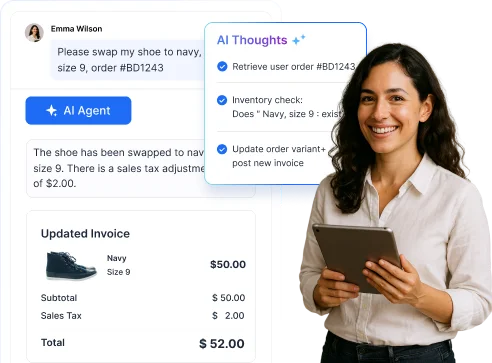


















 Email Ticketing System
Email Ticketing System Shared Inbox Software
Shared Inbox Software Multi Brand Help Desk
Multi Brand Help Desk Internal Help Desk Software
Internal Help Desk Software Trouble Ticketing Software
Trouble Ticketing Software Mobile Help Desk
Mobile Help Desk 










